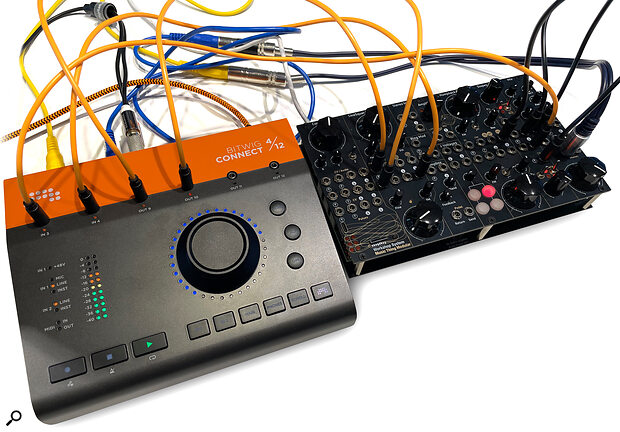Bitwig’s first hardware product takes a characteristically individual approach to audio interfacing.
It seems to be something of a rule that every music software company must, at some stage, get into the hardware business. Ableton played the control surface game with the Push and Push 2, and added audio with the Push 3. Now Bitwig have entered the ring with a desktop audio interface, although its controller features are also deceptively powerful, and it has connectivity clearly aimed at the modular synth market.
First Impressions
The Connect 4/12 is visually striking. It sports a colour scheme incorporating Bitwig’s signature bright orange, and prominently features a large dial on its top surface, much in the style of Universal Audio’s Apollo interfaces or the Mackie Big Knob. The Connect’s case is all metal, and the unit is reassuringly heavy.
The top surface presents the interface’s most unusual feature: a row of 3.5mm sockets, intended primarily for modular synth control but usable for (unbalanced) audio at a pinch. To the left of the big dial are stereo meters calibrated in 4dB increments from ‑40 to 0 dBFS, and status LEDs for audio input type, phantom power and MIDI I/O. There are transport controls bottom left, and mode switches below and to the right of the dial, which itself is set in a 360‑degree ring of LEDs (32 of them).
Mini‑jacks aside, all other connections are on the back panel. Sadly, there’s no silkscreened guide on the top, so you do have to peer over the back and squint a little to see the labels. There are two balanced quarter‑inch audio inputs (one a combi jack to support a microphone), six balanced line outputs, headphone out (annoyingly this isn’t on the front of the device), and two mini‑jacks for MIDI in and out via the bundled adaptors. Power and connectivity (USB 2) are via a USB‑C socket, and there’s no facility to use an external power supply (though at no point in my testing did I feel like I needed one). There’s not even a power switch. Buttons on the back select the input type for inputs 1 and 2 (instrument/line). If there’s an XLR plugged into input 1 then the device assumes a microphone is attached and goes into microphone mode, otherwise not; there’s no manual microphone selection. A dedicated button toggles phantom power. Inputs 1 and 2 can be ganged into a stereo pair, in which case they both operate at line level.
 Round the back we find a USB‑C port, 3.5mm MIDI I/O sockets, and the analogue audio I/O.
Round the back we find a USB‑C port, 3.5mm MIDI I/O sockets, and the analogue audio I/O.
So far so good — and the Connect is class‑compliant so you can just plug it in and you’re away. (Some brief testing confirmed that it also works on a USB‑C‑enabled iPad.) The dial, which is aluminium and feels smooth and solid, lets you set input and output levels: click the relevant button marked In 1, In 2, Main or Phones, then turn the dial, and the ring of LEDs unfurls in orange for visual feedback. The maximum gain for the main two inputs is 30dB for instrument and line input and 62dB for microphone. The minimal setting (no LEDs lit) is unity gain — there’s no way to attenuate. Output is attenuated only, there’s no signal boost.
The Connect claims to be compatible with the Mackie Control protocol. Sure enough, when I fired up Ableton Live and configured the Connect as a Mackie control surface, the transport buttons worked, as did the dial for scrolling. The integration is, shall we say, minimal; the behaviour with Bitwig Studio is much more immersive, as we’ll see.
You are reading one of the locked Subscribers-only articles from our latest 5 issues.
You've read 30% of this article for FREE, so to continue reading...
- ✅ Log in - if you have a Digital Subscription you bought from SoundOnSound.com
- ⬇️ Buy & Download this Single Article in PDF format £0.83 GBP$1.49 USD
For less than the price of a coffee, buy now and immediately download to your computer, tablet or mobile. - ⬇️ ⬇️ ⬇️ Buy & Download the FULL ISSUE PDF
Our 'full SOS magazine' for smartphone/tablet/computer. More info... - 📲 Buy a DIGITAL subscription (or 📖 📲 Print + Digital sub)
Instantly unlock ALL Premium web articles! We often release online-only content.
Visit our ShopStore.

